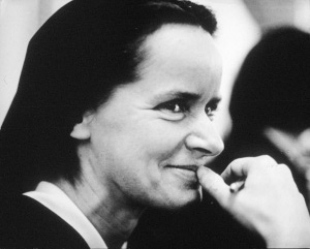If you are unfamiliar with Sister Corita Kent, you are in for a treat! Her website offers this biographical sketch:
"Corita Kent (1918–1986) was an artist, educator, and advocate for social justice. At age 18 she entered the religious order Immaculate Heart of Mary, eventually teaching in and then heading up the art department at Immaculate Heart College. Her work evolved from figurative and religious to incorporating advertising images and slogans, popular song lyrics, biblical verses, and literature. Throughout the ‘60s, her work became increasingly political, urging viewers to consider poverty, racism, and injustice. In 1968 she left the order and moved to Boston. After 1970, her work evolved into a sparser, introspective style, influenced by living in a new environment, a secular life, and her battles with cancer. She remained active in social causes until her death in 1986. At the time of her death, she had created almost 800 serigraph editions, thousands of watercolors, and innumerable public and private commissions."
This video will acquaint you further:
You can view and reflect on a collection of Corita's art here.
To Name This Day . . .
 Quotes
Quotes
See if you can find the connection between these quotes and Corita's art. Which speaks to the artist in you?
“It is a huge danger to pretend that awful things do not happen. But you need enough hope to keep going. I am trying to make hope. Flowers grow out of darkness.”
“Love the moment, and the energy of that moment will spread beyond all boundaries.”
"Not all of us are painters but we are all artists. Each time we fit things together we are creating — whether it is to make a loaf of bread, a child, a day."
 Personal Exploration
Personal Exploration
In 1983, Corita received a commission from Physicians for Social Responsibility and created for them the “we can create life without war” billboards. She called this project the most religious thing she had ever done.
What do you consider to be the most religious thing you have ever done? Describe why you chose this one thing above others and reflect on the values it represents.
 Spiritual Practice
Spiritual Practice
"A painting is a symbol for the universe," Corita wrote. "Inside it, each piece relates to the other. Each piece is only answerable to the rest of that little world. So, probably in the whole universe, there is that kind of total harmony, but we get only little tastes of it."
Today, be mindful of the lovely little details of life that, like parts of a hologram, reflect the magnificent artistry of the whole creation.
